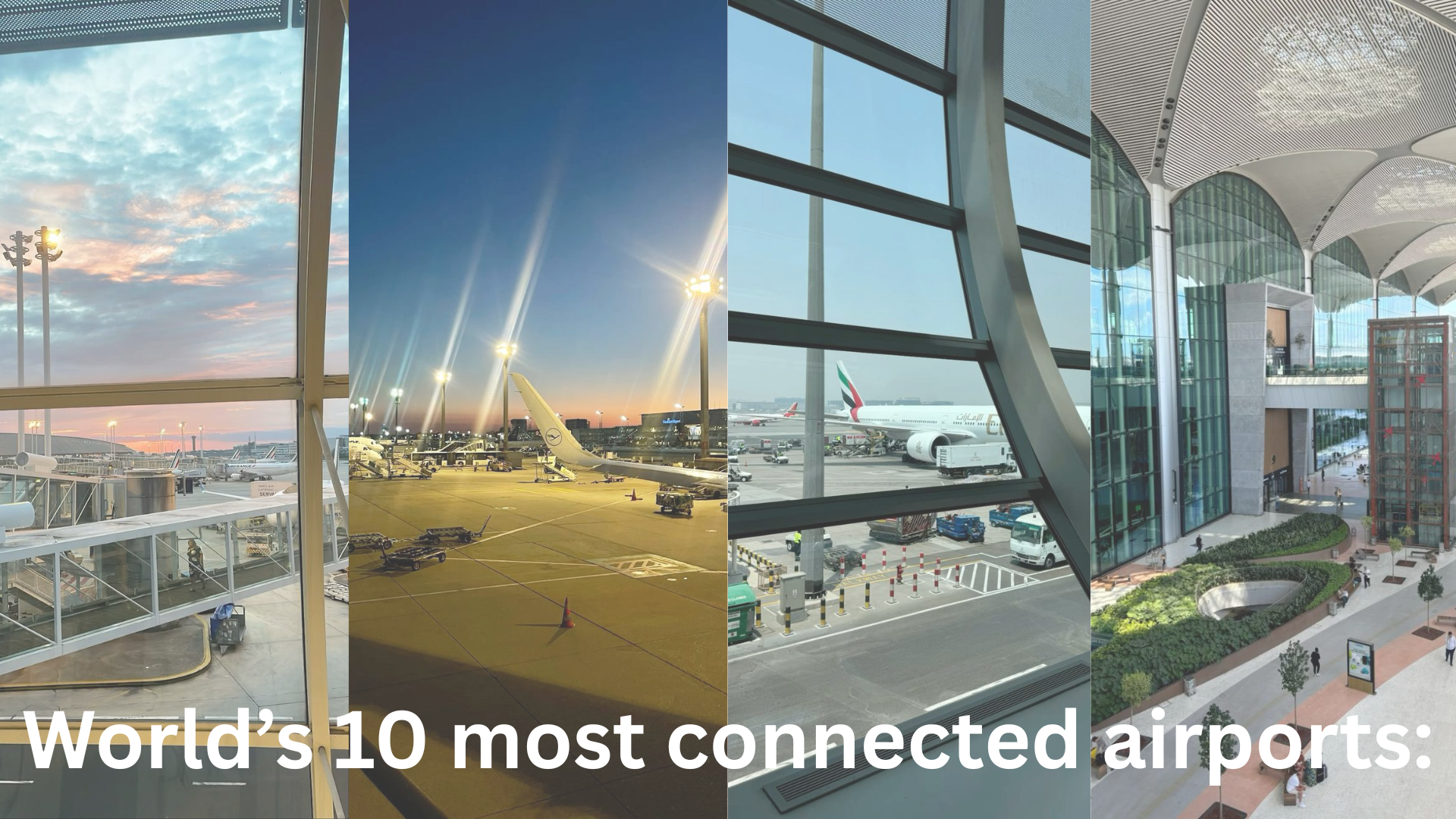In an era of global travel, the most connected airports serve as the backbone of international aviation, facilitating seamless transitions for millions of passengers. These megahubs offer extensive flight networks, efficient operations, and top-tier amenities, making them critical to both business and leisure travelers. Based on recent data from sources like the Airports Council International (ACI) and aviation analytics firm Cirium, here are the world’s 10 most connected airports in 2025, ranked by their nonstop destinations and connectivity indices. This article explores what makes these airports stand out and why they dominate global air travel.
1. Istanbul Airport (IST), Turkey 🇹🇷
Istanbul Airport has emerged as the world’s most connected airport in 2025, boasting 309 nonstop destinations, largely driven by Turkish Airlines’ expansive network. Strategically located at the crossroads of Europe and Asia, IST serves as a vital link to 131 countries, with recent additions like Santiago de Chile, Sydney, and Melbourne. Handling over 80 million passengers annually, the airport’s modern infrastructure, including a single terminal with six runways, supports its rapid growth. Turkish Airlines, operating 300+ destinations, dominates with a modern fleet of Airbus A350s and Boeing 777s, though competitors like Emirates and Qatar Airways add to the hub’s vibrancy. IST’s 59% connectivity increase since 2019 underscores its rise as a global powerhouse.
2. Frankfurt Airport (FRA), Germany 🇩🇪
Frankfurt Airport, a long-standing European hub, ranks second with 296 nonstop destinations. As Lufthansa’s primary base, FRA hosts 99 airlines serving 311 destinations, including key routes to the Americas, Asia, and Africa. Its connectivity, though down 21% since 2019 due to restrictions on Russian airspace, remains robust, with Star Alliance partners like United and Air Canada enhancing its network. FRA’s efficient layout, with two main terminals and a high-speed SkyLine train, ensures smooth transfers. The airport’s 150+ retail stores and premium lounges cater to its 60 million annual passengers, making it a favorite for business travelers.
3. Paris Charles de Gaulle Airport (CDG), France 🇫🇷
Paris Charles de Gaulle, with 282 nonstop destinations, secures third place. As Air France’s main hub, CDG excels in connections to Africa, the Middle East, and North America, handling 4.04 million seats in July 2025. Its four runways and three terminals support a diverse network, with carriers like British Airways and Qatar Airways adding to its reach. CDG’s recent upgrades, including faster security lanes and expanded lounges, enhance the passenger experience. The airport’s proximity to Paris, just 23 km, and its role as a cultural gateway make it a vital hub for global travelers.
4. Amsterdam Schiphol Airport (AMS), Netherlands 🇳🇱
Tied for fourth with 270 nonstop destinations, Amsterdam Schiphol is a key European hub, home to KLM. Its six runways and single-terminal design facilitate efficient connections, particularly to North America and Asia. AMS serves 70 million passengers annually, with a strong presence from low-cost carriers like easyJet alongside legacy airlines. The airport’s sustainability initiatives, including electric ground vehicles, and its extensive shopping and dining options, like the Rijksmuseum branch, make it a standout. Schiphol’s high connectivity index reflects its role as a gateway to Europe and beyond.
5. Chicago O’Hare International Airport (ORD), USA 🇺🇸
Also with 270 nonstop destinations, Chicago O’Hare ranks fifth, climbing to ninth globally in 2025. United Airlines (48% of flights) and American Airlines dominate this hub, which handled 4.76 million seats in July 2025, an 11% increase from 2024. ORD’s $1.3 billion Terminal 5 expansion enhances its capacity for 235 international destinations. With four runways and seven terminals, O’Hare offers extensive domestic and international connections, particularly to Asia and Europe, complemented by premium lounges and dining options.
6. Dubai International Airport (DXB), United Arab Emirates 🇦🇪
Dubai International, the world’s busiest international airport with 5.28 million seats in July 2025, ranks sixth. Emirates, operating 75% of flights, connects DXB to the Middle East, Africa, and Asia with its Airbus A380s and Boeing 777s. The airport’s strategic location and luxurious amenities, including a fitness center and indoor pool, cater to 60.2 million annual passengers. DXB’s 7% capacity growth since 2023 reflects its recovery and role as an East-West connector, with new routes to Latin America boosting its reach.
7. Dallas Fort Worth International Airport (DFW), USA 🇺🇸
Dallas Fort Worth, with 4.72 million seats in July 2025, ranks seventh. American Airlines, with an 85% share, drives DFW’s connectivity to 196 destinations, offering 48,292 potential connections. Its five terminals, linked by the Skylink people mover, handle 80 million passengers annually. DFW’s carbon-neutral status and protected wetlands highlight its sustainability efforts. The airport’s growth, up 18% since 2019, makes it a key North American hub for both domestic and Latin American routes.
8. Shanghai Pudong International Airport (PVG), China 🇨🇳
Shanghai Pudong, with a 29% capacity increase since 2023, ranks eighth, serving 4.14 million seats in April 2025. Its maglev train, the world’s fastest airport connection, links PVG to Shanghai’s center in eight minutes. As a hub for China Eastern and Shanghai Airlines, PVG connects to Asia, Europe, and North America, with 40 sq km of infrastructure supporting cargo and passenger traffic. The airport’s rapid recovery post-pandemic underscores China’s growing aviation influence.
9. London Heathrow Airport (LHR), UK 🇬🇧
London Heathrow, Europe’s busiest airport with 4.53 million seats in July 2025, ranks ninth. British Airways, with a 50% share, connects LHR to North America, Asia, and Africa using Airbus A350s and Boeing 787s. Despite only two runways, LHR’s 51.6 million seats in 2024 reflect its efficiency. Premium lounges, extensive shopping, and a 3% capacity increase since 2023 make it a traveler favorite, though it dropped from first in 2023 to ninth in 2025.
10. New York John F. Kennedy International Airport (JFK), USA 🇺🇸
JFK, with 180 nonstop destinations, rounds out the top 10. Delta Air Lines (35% share) and American Airlines drive connectivity, with a $19 billion overhaul, including the New Terminal One, boosting capacity. Handling 43,500 international connections in August 2023, JFK serves as North America’s most connected hub, linking to Europe, Asia, and Latin America. Its ongoing upgrades aim to improve service, despite a 2023 Skytrax ranking of 88th for traveler experience.
Why Connectivity Matters
Highly connected airports like IST and FRA reduce travel time with more direct flights and flexible connections, crucial for business travelers. They also offer resilience against disruptions, with multiple airlines providing rebooking options. Advanced infrastructure, from smart security lanes at HND to DXB’s luxury amenities, enhances passenger comfort. These hubs drive economic growth, with ORD and DFW acting as regional engines. As global travel surpasses 9.5 billion passengers in 2024, these airports are pivotal to a connected world.
Conclusion
The world’s most connected airports in 2025—Istanbul, Frankfurt, Paris CDG, Amsterdam, Chicago O’Hare, Dubai, Dallas Fort Worth, Shanghai Pudong, London Heathrow, and JFK—represent the pinnacle of global aviation. Their strategic locations, dominant carriers, and cutting-edge facilities ensure seamless connectivity across continents. As air travel grows, with 9.9 billion passengers forecast for 2025, these megahubs will continue to shape the future of global mobility, blending efficiency with traveler-centric innovation.














